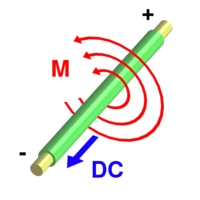Electromagnet
|
|
An electromagnet is a type of magnet in which the magnetic field is induced by a flow of electric current. The magnetic field disappears when the current ceases.

The simplest type of electromagnet is a coiled piece of wire. A coil forming the shape of a straight tube (similar to a corkscrew) is called a solenoid; a solenoid bent so that the ends meet is a toroid. Much stronger magnetic fields can be produced if a "core" of paramagnetic or ferromagnetic material (commonly iron) is placed inside the coil. The field produced by the coil causes the iron to magnetize and generate a field of its own. This field can be hundreds or thousands of times stronger than that of the coil itself.
Magnetic fields caused by coils of wire follow a form of the right-hand rule. If the fingers of the right hand are curled in the direction of current flow through the coil, the thumb points in the direction of the field inside the coil. The side of the magnet that the field lines emerge from is defined to be the north pole.
Electromagnets and permanent magnets
The main advantage of an electromagnet over a permanent magnet is that the magnetic field can be rapidly manipulated over a wide range by controlling the electric current. A disadvantage is that if an electromagnet with a ferromagnetic core is turned on and off again, the core retains some residual magnetization due to hysteresis. This magnetic field can persist indefinitely.
In applications where a variable magnetic field is not required, permanent magnets are generally superior. Since an electromagnet requires a constant flow of electricity, it consumes electrical power. Additionally, permanent magnets can be manufactured to produce stronger fields than any electromagnet of similar size.
Devices that use electromagnets
Electromagnet.JPG
Electromagnets are used in many situations where a rapidly or easily variable magnetic field is desired. Many of these applications involve deflection of charged particle beams; the cathode ray tube and mass spectrometer fall into this category.
Other devices cause electromagnetic fields to interact with fields from permanent magnets and produce forces. Electromagnetic actuators take advantage of the fact that, if the core of a solenoid is displaced toward one end of the coil, a force will occur tending to push the core farther in that direction. Typical uses include relays, electromagnetic door locks, and solenoid valves. Doorbells and similar devices are commonly made by causing the moving core to strike a bell.
Electromagnets are the essential components of many circuit-breakers, they are used in cars in electromagnet brakes and clutches. In some trams, electromagnetic brakes grip directly on to the rails, very high powered electromagnets are even used to lift very heavy scraps of metal. Perhaps the most amazing use of an electromagnet is in the magnetic levitation train electromagnets are mounted to grip at the ends of a pair of structures under the train; the structures wrap around and under each side of the guideway. The magnets are attracted up towards laminated iron rails in the guideway and lift the train so it hovers.
Electromagnets are used in a rotary electric motor to produce a rotating magnetic field that turns the rotor, or in a linear motor to produce a travelling magnetic field that propels the projectile.
See also
fr:Électroaimant it:Elettromagnete nl:Elektromagneet ja:電磁石 pl:Elektromagnes
